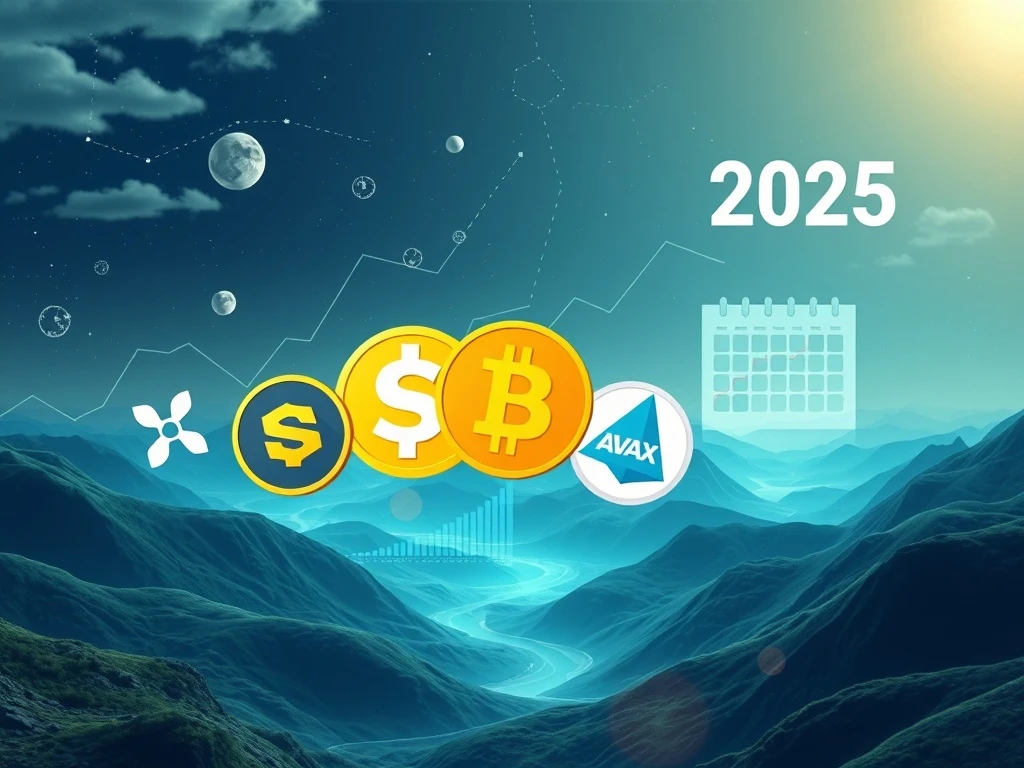Unlocking Future Gains: 2025 Crypto Investment Strategies Featuring XRP, Solana, Cardano, DeSoc, and Avalanche

The cryptocurrency market is a constantly evolving landscape, presenting both exciting opportunities and complex challenges. As we look towards 2025, savvy investors are refining their **crypto investment strategies** to navigate this dynamic environment. While Bitcoin and Ethereum often dominate headlines, a select group of altcoins is quietly carving out significant niches, poised for substantial long-term growth. This article delves into five such cryptocurrencies – Ripple (XRP), DeSoc (SOCS), Solana (SOL), Cardano (ADA), and Avalanche (AVAX) – exploring their unique propositions and why they might be pivotal to your portfolio in the coming years. Understanding their distinct roles and potential is key to making informed decisions in this exciting digital frontier.
Refining Your Crypto Investment Strategies for a Dynamic Market
The digital asset space in 2025 is characterized by rapid technological advancements, shifting regulatory landscapes, and evolving investor priorities. Gone are the days when simply holding a few well-known coins was a sufficient long-term approach. Today, a robust **crypto investment strategy** demands a deeper understanding of underlying utility, ecosystem development, and real-world applications. The five cryptocurrencies highlighted here exemplify this market evolution, each addressing different facets of the decentralized future:
- Ripple (XRP): Focused on institutional finance and cross-border payments.
- DeSoc (SOCS): Pioneering a decentralized social media and creator economy.
- Solana (SOL): Known for its high-speed transactions and robust developer environment.
- Cardano (ADA): Emphasizing peer-reviewed research and sustainable blockchain development.
- Avalanche (AVAX): Building a scalable platform for decentralized applications and subnets.
Each of these projects brings a distinct value proposition to the table, catering to different market needs and investor profiles. Let’s explore what makes them compelling long-term plays.
DeSoc Crypto: Revolutionizing the Creator Economy
Among the contenders, DeSoc (SOCS) emerges as a particularly intriguing asset, positioning itself at the forefront of the decentralized social media and creator economy. Unlike many speculative assets, DeSoc offers immediate utility, allowing users to engage with a Web3 social space from day one. It’s a blockchain-powered platform designed to empower creators by enabling them to syndicate content across multiple networks, monetize their work directly, and foster genuine community engagement.
Here’s what makes the **DeSoc Crypto** project stand out:
- Direct Monetization: Creators can offer microtransactions, gated content, and facilitate peer-to-peer payments directly on the platform, bypassing traditional intermediaries.
- $SOCS Token Utility: The native $SOCS token, currently priced at $0.01, is central to the ecosystem. It enables users to tip creators, access exclusive content, and participate in platform governance through tokenized voting mechanisms.
- Trust-Driven Presale: The presale features locked team tokens and liquidity, alongside a transparent 12-hour refund policy. This approach aims to build investor confidence by addressing common concerns around new project launches.
- Addressing Content Monetization Challenges: DeSoc directly tackles the limitations faced by creators on centralized platforms, offering a more equitable and direct pathway to monetize their digital content and audience.
This focus on individual empowerment and direct utility makes DeSoc a unique and potentially high-growth investment, particularly as the Web3 social landscape continues to mature.
XRP Price Prediction: Institutional Appeal and Cross-Border Payments
Ripple’s XRP has long been a focal point for investors interested in the intersection of blockchain and traditional finance. Its primary utility lies in facilitating fast, low-cost cross-border payments, a solution that has garnered significant traction among financial institutions globally. The proposed $300 million reserve plan from WebusInternational further underscores the institutional confidence in XRP’s underlying technology and its potential to revolutionize global remittances.
Currently trading around $3.2, the **XRP price prediction** for 2025 remains a topic of considerable debate, heavily influenced by ongoing regulatory clarity and adoption by major financial players. While XRP excels in addressing institutional-scale problems, its appeal to retail users remains comparatively limited. Unlike platforms like DeSoc, XRP doesn’t inherently offer features for individual content creators or direct peer-to-peer tipping mechanisms, which can be a point of divergence for retail investors seeking immediate, tangible utility in their daily digital interactions. Analysts often highlight this dichotomy: XRP is designed for the pipes of global finance, while projects like DeSoc focus on empowering the individual digital participant.
Solana SOL Outlook: Speed, Scalability, and Developer Ecosystem
Solana (SOL) has established itself as a formidable competitor in the blockchain space, celebrated for its high transaction throughput and low fees. These attributes make it an attractive platform for decentralized applications (dApps), especially in sectors requiring high performance, such as gaming, NFTs, and decentralized finance (DeFi). Despite a recent 1% dip over seven days, the **Solana SOL outlook** remains optimistic for many analysts.
Bybit analyst Christiaan, for instance, predicts a potential rebound for SOL to the $400–$450 range, citing strong support levels and favorable U.S. regulatory conditions that could further bolster its growth. Solana’s continuous innovation in scaling solutions and its vibrant developer community are key strengths that promise sustained development and adoption. However, for the average retail user, Solana’s utility might still feel somewhat abstract compared to the direct creator-focused model of platforms like DeSoc. While it powers complex ecosystems, its direct application for individual content monetization or social interaction is less pronounced, leading to different investor considerations based on their utility preferences.
Cardano ADA Potential: Academic Rigor Meets Blockchain Innovation
Cardano (ADA) stands out for its unique, research-driven approach to blockchain development. Built on peer-reviewed academic research, Cardano prioritizes security, sustainability, and scalability, aiming to provide a robust and energy-efficient platform for decentralized applications and smart contracts. Trading at approximately $0.81, the **Cardano ADA potential** for significant long-term growth is often linked to its methodical development roadmap and its ability to deliver on its ambitious vision.
Analysts forecast a potential rise to $1.21 if ADA successfully holds key support levels, with its long-term trajectory often considered in relation to Ethereum’s performance and market dominance. Cardano’s commitment to energy efficiency positions it favorably in an increasingly environmentally conscious world. While its deliberate pace of development ensures stability and thoroughness, it also means that some immediate use cases, particularly for creators seeking integrated monetization tools, might not be as readily available or intuitive as on platforms like DeSoc. Cardano’s strength lies in its foundational integrity and long-term vision for a globally adopted, secure, and decentralized infrastructure.
Avalanche (AVAX): Powering Decentralized Systems and DeFi Resilience
Avalanche (AVAX) continues to build out a robust infrastructure designed to power a wide array of decentralized systems, including AI agents and complex DeFi applications. Its innovative subnet architecture allows for highly customizable and scalable blockchain networks, attracting various projects and partnerships, such as with Youmio. With over 6 million funded wallets, Avalanche demonstrates a growing ecosystem and user base.
The **AVAX** price rebound over the past six months to $24.14 reflects its resilience in the competitive DeFi landscape and its ability to facilitate efficient cross-chain applications. While Avalanche is a powerhouse for developers and sophisticated decentralized finance, its relevance to everyday users, particularly those in the creator economy seeking direct monetization tools, remains more limited compared to the direct focus of platforms like DeSoc. AVAX’s growth is heavily dependent on the overall health and expansion of the DeFi sector and strategic corporate treasury allocations into blockchain solutions.
Market Dynamics and Shifting Investment Paradigms
The cryptocurrency market in 2025 showcases a clear divergence between institutional-grade blockchains and more niche, user-centric projects. While established players like Solana and Cardano benefit from robust infrastructure and extensive developer networks, newer entrants like DeSoc and established giants like XRP navigate their growth paths influenced by regulatory clarity and market sentiment. Avalanche’s trajectory, similarly, is closely tied to the broader DeFi landscape and corporate blockchain adoption.
Bitcoin and Ethereum, as market leaders, continue to exhibit mixed trends, underscoring the inherent volatility of the digital asset space. However, the five assets discussed – XRP, DeSoc, SOL, ADA, and AVAX – stand out for their targeted use cases and distinct value propositions:
- Ripple (XRP): Aligns with growing institutional blockchain adoption for cross-border payments.
- Solana (SOL): Expands utility through partnerships in gaming and NFT platforms, leveraging its speed.
- Cardano (ADA): Focuses on long-term, research-driven upgrades for a sustainable ecosystem.
- Avalanche (AVAX): Offers infrastructure resilience for DeFi and enterprise solutions.
- DeSoc (SOCS): Carves out a unique space in the burgeoning decentralized creator economy.
Investor sentiment remains a crucial factor, especially for newer projects like DeSoc. Its success hinges significantly on the mainstream adoption of decentralized social platforms. Unlike the other four, DeSoc’s value is more directly tied to a narrower, albeit rapidly growing, audience of creators and consumers within the Web3 social sphere. Its viral presale and low entry cost make it an attractive, albeit speculative, play for those looking for high-risk, high-reward opportunities. Similarly, AVAX’s performance will be heavily influenced by DeFi’s ability to compete and innovate against Ethereum’s scaling solutions like rollups.
Conclusion: Navigating the Future of Digital Assets
As we navigate the complexities of the 2025 cryptocurrency market, a diversified and informed **crypto investment strategy** is paramount. The five cryptocurrencies discussed – XRP, DeSoc, Solana (SOL), Cardano (ADA), and Avalanche (AVAX) – each offer compelling long-term potential, albeit with distinct risk profiles and utility propositions. From institutional-grade payment solutions to revolutionary creator economy platforms and scalable infrastructure, these assets reflect the multifaceted evolution of the digital asset landscape.
While past performance is not indicative of future results, understanding the fundamental strengths and challenges of each project is essential. DeSoc’s focus on immediate utility for creators, XRP’s institutional adoption, Solana’s speed, Cardano’s academic rigor, and Avalanche’s infrastructure resilience collectively present a fascinating array of opportunities. As always, thorough research, risk assessment, and aligning investments with your personal financial goals are crucial for success in this exciting and ever-changing market.
Frequently Asked Questions (FAQs)
Q1: What makes DeSoc (SOCS) a unique long-term investment compared to other cryptocurrencies?
DeSoc stands out due to its immediate utility as a blockchain-powered social platform focused on empowering creators. It offers direct monetization features like microtransactions, gated content, and peer-to-peer payments, along with a trust-driven presale, making it less speculative than many new tokens by providing tangible value from day one in the Web3 social space.
Q2: How does XRP’s utility differ from that of Solana (SOL) or Cardano (ADA)?
XRP is primarily designed for institutional cross-border payments, aiming for speed and low cost in global remittances. In contrast, Solana (SOL) focuses on high-speed, scalable infrastructure for decentralized applications, gaming, and NFTs, while Cardano (ADA) emphasizes a research-driven, energy-efficient platform for smart contracts and sustainable development. Their target markets and core functionalities are distinct.
Q3: What are the key factors influencing Solana (SOL) and Cardano (ADA) price predictions for 2025?
For Solana (SOL), key factors include its continued development of high-speed infrastructure, growth in its developer ecosystem, adoption in gaming and NFT sectors, and favorable regulatory conditions in key markets like the U.S. For Cardano (ADA), its long-term potential hinges on the successful implementation of its academic-driven upgrades, its energy efficiency, and its ability to secure wider adoption for its smart contract platform, often considered in relation to Ethereum’s market performance.
Q4: Why is a diversified crypto investment strategy important for 2025?
A diversified crypto investment strategy is crucial because the market is highly volatile and each asset carries unique risks and opportunities. By investing in a range of cryptocurrencies with different use cases (e.g., institutional payments, creator economy, scalable infrastructure), investors can mitigate risks associated with any single project and potentially capture growth from various segments of the evolving digital asset landscape.
Q5: What role does Avalanche (AVAX) play in the broader decentralized ecosystem?
Avalanche (AVAX) serves as a highly scalable platform for launching decentralized applications and custom blockchain networks (subnets). It’s particularly strong in the DeFi sector and for powering AI agents and other complex decentralized systems. Its resilience and ability to facilitate efficient cross-chain applications make it a significant player in the infrastructure layer of the Web3 economy.









